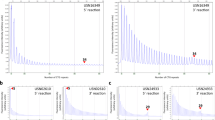Abstract
We report the characterization of a length polymorphism in the human dystrophin gene, consisting of single-base pair increments in a polyadenosine tract located near the 3′ end of exon 68. Using Single Strand Conformation Analysis (SSCA), three length alleles could be identified (10182 + 13A9/10/11). This class of 1-bp length variant is rare among known intronic gene sequences, and has been described only once in the dystrophin gene. Furthermore, the high polymorphic content (0.56) of this novel marker and its distal localization in the 3′ end of the coding sequence make it suitable for diagnostic purposes.
Similar content being viewed by others
References
Beaudet AH, Tsui LC (1993) A suggested nomenclature for designating mutations. Hum Mutat 2:245–248
Bebchuk KG, Bulman DE, D'Souza VN, Worton RG, Ray PN (1993) Genomic organization of exons 22 to 25 of the dystrophin gene. Hum Mol Genet 2:593–594
Clemens PR, Fenwick RG, Chamberlain JS, Gibbs RA, Andrade M de, Chakraborty R, Caskey CT (1991) Carrier detection and prenatal diagnosis in Duchenne and Becker muscular dystrophy families, using dinucleotide repeat polymorphisms. Am J Hum Genet 49:951–960
Lenk U, Hanke R, Thiele H, Speer A (1993) Point mutations at the carboxy terminus of the human dystrophin gene: implication for an association with mental retardation in DMD patients. Hum Mol Genet 2:1877–1881
Levinson G, Gutman GA (1987) Slipped strand mispairing: a major mechanism for DNA sequence evolution. Mol Biol Evol 4:203–221
Oudet C, Heilig R, Mandel JL (1990) An informative polymorphism detectable by polymerase chain reaction at the 3′ end of the dystrophin gene. Hum Genet 84:283–285
Oudet C, Heilig R, Hanauer A, Mandel JL (1991) Non radioactive assay for new microsatellite polymorphisms at the 5′ end of the dystrophin gene, and estimation of intragenic recombination. Am J Hum Genet 49:311–319
Ravnik-Glavac M, Glavac D, Komel R, Dean M (1993) Single-stranded conformation polymorphism analysis of the CFTR gene in slovenian cystic fibrosis patients: detection of mutations and sequence variations. Hum Mutat 2:286–292
Rininsland F, Reiss J (1994) Microlesions and polymorphisms in the Duchenne/Becker muscular dystrophy gene. Hum Genet 94:111–116
Roberts RG, Coffey AJ, Bobrow M, Bentley DR (1993) Exon structure of the human dystrophin gene. Genomics 16:536–538
Roberts RG, Gardner R, Bobrow M (1994) Searching for the 1 in 2,400,000: a review of dystrophin gene point mutations. Hum Mutat 4:1–11
Tuffery S, Demaille J, Claustres M (1992) A new intragenic polymorphism detected by the single strand conformation polymorphism (SSCP) assay in the dystrophin gene. Hum Mutat 1:221–223
Tuffery S, Moine P, Demaille J, Claustres M (1993) Base substitutions in the human dystrophin gene: detection by using the single-strand conformation polymorphism (SSCP) technique. Hum Mutat 2:368–374
Author information
Authors and Affiliations
Rights and permissions
About this article
Cite this article
Tuffery, S., Moine, P., Demaille, J. et al. Identification of variable length polyadenosine tract at the dystrophin locus. Hum Genet 95, 590–592 (1995). https://doi.org/10.1007/BF00223878
Received:
Issue Date:
DOI: https://doi.org/10.1007/BF00223878




